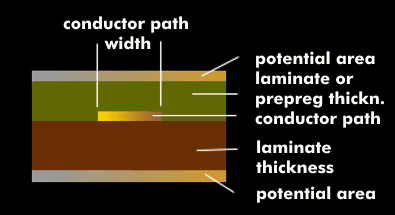stripline
Striplines and microstrips are transmission lines for transmitting high- frequency signals with defined transmission behavior via printed circuit boards. Both techniques were developed in the middle of the last century and differ in some details. While in the stripline the conductors are embedded in a kind of sandwich between two potential surfaces, the microstrip works with only one potential surface.
Technically, the stripline simulates a high-frequency cable with defined impedance. The two outer potential surfaces form the outer conductor, the conductor track between them the inner conductor. The laminate of the printed circuit board is the dielectric between the lower potential surface and the inner conductor track. Above the conductor track is the prepreg, which is thermoset material made of pre-impregnated fibers. The impedance of the stripline is determined by the width of the conductor as well as by the thickness of the laminate and the prepreg and their permittivity. The greater the laminate and prepreg thickness, the higher the impedance. In contrast, the trace thickness has only an insignificant effect on the impedance of the stripline: the thicker the trace, the lower the impedance. Doubling the trace thickness results in an impedance reduction of about 1 % to 2 %.
The advantages of both techniques, the stripline and the microstrip, lie in the manufacturing technique, since they can already be taken into account in PCB planning and no RF connectors have to be installed on the PCB itself. In contrast to the microstrip, the stripline is shielded against electromagnetic fields on both sides by the two potential surfaces.

